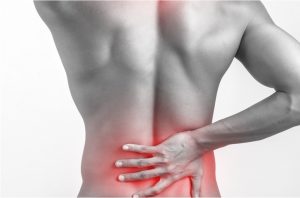
Lower Back Pain – disc bulge
What is this condition? What causes this condition?
A disc herniation, or sometimes called a disc bulge, slipped disc or a disc prolapse, is a condition related to the discs in the vertebral spine. Discs sit between each vertebrae and act to absorb forces whilst keeping the spine stable. In the event of a disc herniation, some of the material from the inside of the disc may have displaced into the space around it. Although, typically it isn’t the disc bulge itself that causes pain, rather compression and/or inflammation of nearby nerves can produce symptoms of pain that may radiate down the back to the legs (Yang et al. 2015). Many people can have a disc herniation and not experience any pain. In fact the older we get, the more common disc herniations are without causing any pain.
A herniated disc can be caused by a single event such as a sudden painful moment when lifting a heavy object, or can occur over time with repeated mechanical activities. This article will explore the lumbar herniations as they are the most common, although disc herniations can rarely occur in the thoracic and cervical regions.
Common symptoms / signs
Common symptoms experienced by people with painful disc hernias typically have a diffuse soreness around the lower back, which may be on both sides or more on one side. Pain is usually quite significant and can be debilitating. They may also experience numbness or other sensational changes with the pain and can travel down the buttocks which may then extend down the leg. Pain or sensational changes may increase with certain movements such as bending forward or backwards, walking, squatting, twisting, holding breath, or coughing, although this can vary between persons. Often, people with disc hernias may have changed the way they walk or how they get on and off a chair due to pain.
How is it treated?
Exercises can help the process of improving pain from irritated nerves due to a disc hernia, particularly as our body can sometimes adapt to the pain by avoiding the painful movements, although maladaptive movements can prolong and worsen symptoms. The best thing we can do for disc hernias is to continue moving and maintaining our physical activity (Stochkendahl et al. 2018).
Exercises may start with promoting movement of the lower back whilst minimising provocative movements (VanGelder et al. 2013). Then strengthening of the muscles that support our lower back which can improve mobility with less pain, particularly for those who may experience weakness or have had lower back pain for a prolonged time and have been participating in less physical activities. Ongoing rehabilitation involves further strengthening and regaining trunk mobility.
Other causes
Lower back pain is experienced by 50-80% of people at least once in their lifetime (Fatoye et al. 2019). Herniated discs is one possible cause of low back pain, however, there are many other structures that may be the cause of pain. Such as, pathologies of the bony vertebrae, vascular conditions or muscular pains.
References
Fatoye, F., Gebrye, T., & Odeyemi, I. (2019). Real-world incidence and prevalence of low back pain using routinely collected data. Rheumatology international, 39(4), 619-626.
Stochkendahl, M. J., Kjaer, P., Hartvigsen, J., Kongsted, A., Aaboe, J., Andersen, M., … & Vaagholt, M. (2018). National Clinical Guidelines for non-surgical treatment of patients with recent onset low back pain or lumbar radiculopathy. European Spine Journal, 27(1), 60-75.
VanGelder, L. H., Hoogenboom, B. J., & Vaughn, D. W. (2013). A phased rehabilitation protocol for athletes with lumbar intervertebral disc herniation. International journal of sports physical therapy, 8(4), 482.
Yang, H., Liu, H., Li, Z., Zhang, K., Wang, J., Wang, H., & Zheng, Z. (2015). Low back pain associated with lumbar disc herniation: role of moderately degenerative disc and annulus fibrous tears. International journal of clinical and experimental medicine, 8(2), 1634.
